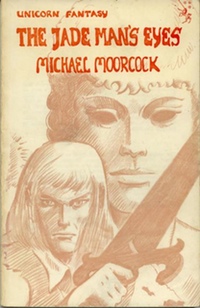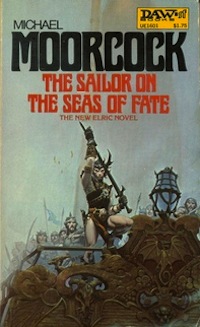Welcome back to the Elric Reread, in which I revisit one of my all-time favorite fantasy series, Michael Moorcock’s Elric saga. You can find all the posts in the series here. Today’s post discusses The Sailor on the Seas of Fate, published in 1976.
The Sailor on the Seas of Fate has never really been my favorite Elric book. Where The Fortress of the Pearl stands quite well on its own and in the continuity, Sailor is a little more awkward; it’s as if you can see more of the welding marks in its insertion into Elric’s continuity between the origin story of Elric of Melniboné and his downfall of The Weird of the White Wolf; where that book actually feels like a cohesive work, despite being composed of short stories published months, even years apart, Sailor feels disjointed, its structure forced. However, even a comparatively underwhelming Elric book has more going for it than your usual high fantasy offering.
In “Sailing the the Future,” we begin with Elric desperate and hunted on a desolate shore, his only means of escape a mysterious ship sailed by a blind captain. Here he meets three unusual adventurers: Erekosë, Dorian Hawkmoon, and Corum Jhaelen Irsei, the last of whom remembers another adventure with Elric and Erekosë. To Elric, this is nonsense—though as we shall see later, Corum speaks of an exploit that lies yet in his future.
If you’re new to Moorcock, and if you’re proceeding in this particular order, this will be your first encounter with other manifestations of the Moorcockian figure of the Eternal Champion: the archetype of a doomed hero, bound to a supernatural weapon, fated to fight on the side of Law or Chaos in order to maintain the Balance between the two forces. Hawkmoon, Corum, and Erekosë are, in effect, crossing over from their own series into Elric’s for this tale. Erekosë, who somehow manages to be even gloomier and more self-pitying than Elric (relatively easy at this point, but no small feat as the series progresses), remembers other lives and names: “I have been called Urlik Skarsol and John Daker and Ilian of Garathorm […] Some would have me believe that I have been Elric Womanslayer…” Corum is not the only character to offer foreshadowing of Elric’s eventual destiny.
The four Champions, accompanied by four warrior companions, are sent by the blind captain to battle a pair of twin sorcerers, Agak and Gagak, Galactus-like world devourers. There’s a fairly brilliant “the call is coming from inside the house” moment when the Champions realize that the enormous, weirdly dank building they’ve been fighting their way through is in fact the body of Gagak herself, and the moment where the four join together to become a monstrous, eight-armed, eight-legged being is both exhilarating and horrible: “‘Oh, no, no…’ And this was Hawkmoon, but the words came from Elric’s lips.”
This adventure is both disturbing and revelatory for Elric, but unfortunately the narrative and continuity demands that the moment he parts ways with the Champions and the blind captain, the entire battle fades from memory, becoming little more than a half-remembered dream. He begins the second story, “Sailing to the Present,” cast up on another strange shore, recalling the hunt that drove him to the dark ship, but not the events that transpired. What follows is probably one of the most conventional high-fantasy stories in the Elric saga, involving a legendary Melnibonéan nobleman named Saxif D’an, a woman who is a dead-ringer for the human princess he loved and killed (in best Gothic fashion, he believes poor Vassliss, a merchant’s daughter, is a reincarnation of the original), and the half-Melnibonéan Prince Carolak, who also loved the princess and has pursued her killer ever since, all the way into another parallel world. Here Elric also meets a new friend, Count Smiorgan Baldhead, a human nobleman and sailor, and a classic bluff-and-hearty sidekick who acts as a foil to Elric’s own moodiness and tendency to philosophize. Elric here is largely a facilitator of the further drama of Saxif D’an, Vassliss, and Carolak, making it possible for the good guy to ride off into the sunset with the girl at the end.
 It’s an oddly charming story, if slight (and a little annoying for the way Vassliss happily and unquestioningly falls into Carolak’s arms in the end), and what follows in “Sailing to the Past” is thus all the more harsh in contrast. The tale here originally appeared as a chapbook called “The Jade Man’s Eyes” (which was, as Richard Grey notes in “One Life, Furnished in Early Moorcock,” printed in green ink). This story fit into Elric’s continuity after the events of The Sleeping Sorceress (two books down the line from this one) and Elric’s sidekick was a fellow we’ll meet in the next installment of this reread, Moonglum of Elwher. More about him when we get there. In putting together The Sailor on the Seas of Fate, Moorcock substantially reworked “The Jade Man’s Eyes,” replacing Moonglum with Smiorgan Baldhead, and having Elric picked up at sea by the explorer Duke Avam Astran, rather than being peeled off the streets of a city.
It’s an oddly charming story, if slight (and a little annoying for the way Vassliss happily and unquestioningly falls into Carolak’s arms in the end), and what follows in “Sailing to the Past” is thus all the more harsh in contrast. The tale here originally appeared as a chapbook called “The Jade Man’s Eyes” (which was, as Richard Grey notes in “One Life, Furnished in Early Moorcock,” printed in green ink). This story fit into Elric’s continuity after the events of The Sleeping Sorceress (two books down the line from this one) and Elric’s sidekick was a fellow we’ll meet in the next installment of this reread, Moonglum of Elwher. More about him when we get there. In putting together The Sailor on the Seas of Fate, Moorcock substantially reworked “The Jade Man’s Eyes,” replacing Moonglum with Smiorgan Baldhead, and having Elric picked up at sea by the explorer Duke Avam Astran, rather than being peeled off the streets of a city.
Elric’s sea-rescuer, Duke Avan, is a renowned explorer who seeks a lost city called R’lin K’ren A’a, which—according to legend—is the ancestral home of the Melnibonéan race. There, Duke Avan believes he will find a pair of legendary jewels that form the eyes of an enormous jade statue located in that city. Elric is dismissive at first, but eventually allows himself to be persuaded. The expedition starts to go hideously wrong almost from the moment they reach the Western Continent where the city is said to lie: the crew is decimated by hideous reptilian creatures wielding razor-sharp stone discs and which are scarcely affected by Stormbringer, and once they reach the city, they discover that the Jade Man’s Eyes are gone.
Their only way out lies with the unfortunate Creature Doomed To Live, J’osui C’reln Reyr, a kind of Wandering Jew figure who has been cursed with eternal life by the Lords of Law and Chaos for spying on them. To escape, Elric must break the curse that binds the Creature, summoning his patron demon Arioch to inhabit the great jade statue. Arioch does not come willingly and demands blood as a price—and not for the last time, one of Elric’s allies must pay that price.
The essential bleakness of the original chapbook is definitely present in this rework, though it feels a little odd at this placement in the continuity. Much is made of Elric’s dependence on Stormbringer, as well as the sword’s unfortunate tendency to overreach its wielder’s intended targets—and at this point in the series, neither of these tropes has yet become as central as they eventually will. The original “Jade Man’s Eyes” is perhaps a somewhat stronger story, particularly as Elric’s characterization is more consistent with the stories that take place later in his personal chronology. That being said, it’s possible to read “Sailing to the Past” as the point where Elric’s worldview starts to truly darken, transforming him to the nihilistic figure we’ll see in the next volume.
Up next: the fall of Imrryr, the Dreaming City.
Publication Notes:
UK Hardcover, Quartet, 170pp., ISBN: 0-7043-2110-6, 15 Mar 1976, Cover by Patrick Woodroffe
US Mass Market Paperback, DAW, ISBN: 0-87997-601-2, Dec 1976, Cover by Michael Whelan
Included in Duke Elric, vol. 4 of The Chronicles of the Last Emperor of Melniboné, Del Rey, 2009
New edition published by Gollancz in September 2013
“The Jade Man’s Eyes” is included in To Rescue Tanelorn, vol. 2 of The Chronicles of the Last Emperor of Melniboné, Del Rey, 2008.
Karin Kross lives and writes in Austin, TX. She can be found elsewhere on Tumblr and Twitter.










